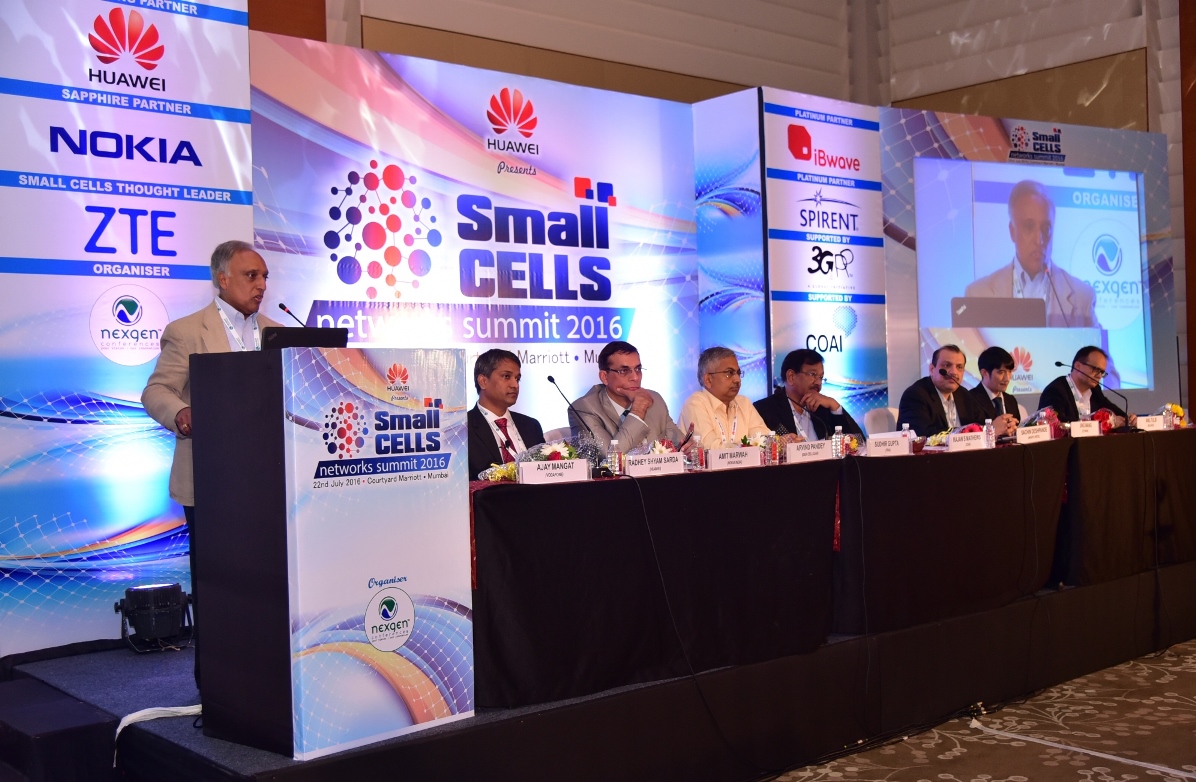Small Cells Networks Summit 2016 concluded on a successful note with the participation of key industry  leaders from the government, industry associations, telecom operators and telecom companies. The summit was presented by Huawei and organized by Nexgen Conferences, one of India’s leading conferences & B2B event organizer. This summit was held at The Courtyard Marriott in Mumbai and was designed to ensure highly focused communication across all segments of small cells network including all ecosystems to come together under one roof to exchange ideas, develop expertise and share best practices.
leaders from the government, industry associations, telecom operators and telecom companies. The summit was presented by Huawei and organized by Nexgen Conferences, one of India’s leading conferences & B2B event organizer. This summit was held at The Courtyard Marriott in Mumbai and was designed to ensure highly focused communication across all segments of small cells network including all ecosystems to come together under one roof to exchange ideas, develop expertise and share best practices.
Speaking on the occasion, Sudhir Gupta, Secretary, Telecom Regulatory Authority of India (TRAI) said, “The demand for internet data is increasing day by day, and soon India would be among top countries in terms of rate of increasing demands. On the other hand, we have peculiar problems in our nation including wrong perceptions that towers and BTS have health hazards associated with them as well as the major problem of call drops”.
“With Small Cells as Service (SCAS) and Internet Protocol (IP) providers, people could receive a complete network and best of the services from telecom operators. Without small cells, I doubt if we would ever be able to achieve the technology projects such as smart cities.” Gupta further added.
Rajan S. Mathews, Director General of COAI expressed his views on the industry perspective about where the smart cells fit in and asserted that India is going to be a place for telecommunication revolution.
“QoS standards, call drops, affordability in terms of customer experience, high speed internet, technology development and proper investments in networks are the key areas where significant amount of work should be done in order to provide customer satisfaction,” said Mathews.
“Increasing IPfication of networks holds the focus of telecom industry and small cells would play a significant role in making India to be a place for telecommunication revolution.” Mathews further added.
“Consumption of internet with the proliferation of smart phone devices in India is similar to global market and network is getting evolved by adding complexities to it and making available newer spectrum. Licensed-Assisted Access (LAA) and evolution of LTE would provide operators the option to make use of unlicensed spectrum with a unified network, with potential operational cost saving and improved spectral efficiency.” said Sachin Deshpande, Head of Smart Cells, Bharti Airtel.
“Road to small cell 2020 follows the path to find the smart cell solutions for the evolution of telecommunications and to bring newer opportunities and challenges to the industry by MBB 2020. The subsequent increase in cellular Internet of Things (IOT) connections as well as in speed is necessary to evolve the network and to keep a control on data traffic.” ,” said Radhey Shyam Sarda, Solutions Director- Wireless, Huawei Telecommunications (India) Co. Pvt. Ltd.
Addressing the audience, Anil Tulsi, Head- Strategy Panning, Reliance Communications said, “The point of concern should be the location where small cell has to be deployed so as to achieve the desired goal and to make it cost effective.”
Jing Wang, Small Cells Marketing Director, ZTE India, “Deployment of small cells is necessary for high speed experience at the user end and extension of coverage as 70% of network consumption happens in indoor area. The small cell family such as Q cell, Nanocell has wide range of application to absorb indoor as well as outdoor traffic in different scenarios. Offering of PtP and PtMP radios with small cell deployment for urban application overcome the major challenges associated with street-level backhaul.”
Amit Marwah, Head E2E Sales Solutions, Nokia India said, “India’s mobile data is growing in leaps and bounds and the way data is consumed in India is similar to its consumption globally.”
“There exist several challenges for the set up of small cells in terms of related site, health, civic body approved guidelines, public acceptance and so on. However, managing network complexity would essentially provide solutions such as self-optimizing, self-healing and a lot more.” Marwah further added.
‘Small Cells Networks Summit 2016’ witnessed huge participation from telecom industry professionals and thought leaders. The summit was sponsored by well-known organizations such as Huawei, Nokia, ZTE, iBwave, Spirent and supported by 3GPP & Cellular Operators Association of India (COAI).
Anjani Kumar Singh, CEO, Nexgen Conferences said, “We are delighted to receive such a great response from the telecom industry professionals and thought leaders for Small Cells Networks Summit 2016. This summit created an interactive platform to successfully engage key players and thought leaders of the telecom industry to discuss about the challenges associated with small cells deployment and their respective solutions.”






